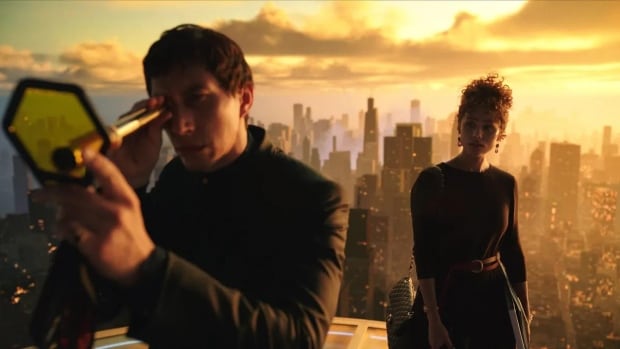
There were two instances of audience interaction at the Toronto International Film Festival’s lone press screening of Megalopolis.
The first involved a man, ostensibly hired by the production team, who stood up midway through the movie and walked to the front of the theatre. As the house lights inexplicably went up, he went to a microphone stand hidden off to the side, looked down at a piece of paper and asked Adam Driver’s on-screen character a question. A recording of Driver’s character looked down from the screen and responded, as if in a press conference.
This fourth wall-breaking element of the movie has been widely reported on as occurring at other screenings and built substantial buzz around the movie’s ambitious and unorthodox techniques. But at the TIFF screening, there was another. In a scene where one of our dizzying cast of characters is arrested, police sirens go off. At the time, an actual alarm blared throughout the theatre, ringing considerably louder than the sirens on screen.
In a testament to the bizarre, self-indulgent mess that is Megalopolis, it took me 20 minutes to realize the alarm wasn’t another experimental part of the movie. It was just an alarm.
It’s around here that a normal review would subtly transition to a summary of the plot. Unfortunately, Megalopolis is such a rambling, boring slog, I’m not sure I grasped the story writer and director Francis Ford Coppola actually had in mind.
WATCH | Megalopolis trailer:
What I could keep track of is this: inexplicably influential architect Cesar Catilina (Driver), vindictive mayor Franklyn Cicero (Giancarlo Esposito) and influential banker Hamilton Crassus III (Jon Voight) are locked in a sort of power struggle for the future of the fictional city of New Rome. At the same time, outside elements — including Crassus’s scheming, power-hungry son Clodio Pulcher (Shia LaBeouf) and corrupt newshound Wow Platinum (Aubrey Plaza) — are willing to do just about anything to find themselves at the top of the pile when that struggle comes to an end.
There’s also Franklyn’s idealistic daughter Julia Cicero (Nathalie Emmanuel) and Catilina’s dedicated assistant and the film’s narrator Fundi Romaine (Laurence Fishburne), who attempts to support Catilina in his endeavours to remake the city. Along with those characters — and a baker’s dozen of other equally obtrusive names — there’s a convoluted mix of subplots involving time manipulation, magical metal and a decommissioned satellite hurtling toward Earth.
More than 300 rewrites over span of decades
To be fair, “mix” may not actually be the best word. Because these elements do not come together to build a message out of the madness — namely, a warning about the internal forces that take down empires such as Rome and the United States, according to Coppola.
Instead, Megalopolis stands as a testament to mixed metaphors, flabby writing and the stubborn self-assuredness of thinking you’re the smartest person in the room.
Part of this incomprehensible slew of ideas could have come from the process behind them. A passion project for Coppola, Megalopolis has apparently suffered through more than 300 rewrites over the span of decades, according to Variety. That includes daily adjustments, rewrites and additions — as Emmanuel shared on the red carpet at TIFF — while the film was being shot.
The intent to compare the fall or Rome with the projected fall of the U.S. does lead to one of Megalopolis‘s sole points of value. The parallels between Megalopolis‘s Cicero and Catilina and their Roman counterparts’ competing interpretations of the value of the republic — as well as their involvement in the Catilinian plot to overthrow it — will be interesting to those with an eye for history.

But with this collage of inspirations, instead of getting Baz Luhrmann’s Romeo + Juliet, we get something more like Sean Penn’s infamously unintelligible Trump-inspired novel Bob Honey Who Just Do Stuff.
Coppola hides any interesting examinations behind an impenetrable fog of symbols. There are crying statues laying their weapons down on the ground as Catilina drives by them. There are ghosts of long-lost lovers lying in secret rooms. There are political rallies with some dim intended commentary on modern politics. But it’s all so scattered and poorly engineered that it makes little to no sense to anyone but Coppola and the most generous audience members willing to devise a meaning for themselves.
If nothing else, Megalopolis will teach creators one thing: inaccessibility isn’t a virtue. The unfortunate lesson every ambitious young screenwriter needs to learn is that stuffing your story with so many high-minded metaphors that your viewers are left scratching their heads doesn’t make you a genius.
Self-funded effort
Challenging and innovative messages are a high bar that the best storytellers occasionally clear, but it is only after satisfying their first responsibility to the audience: to make something with intention, and work to make yourself understood.
Self-funded with more than $100 million US by an artist who is impossibly wealthy after early career successes, Megalopolis works against its audience. This was presaged by the early promotion of the movie, which generated fake quotes from high-profile critics, pushing the narrative that Coppola is a misunderstood genius forced to curtail his iconoclastic plans because of a hostile public.
By paying for everything himself, he is able to do what he’s never been able to before: bypass wary investors who might push back against antagonizing an audience with self-important nonsense.
Inaccessible to the point of satire, Megalopolis also tarnishes Coppola’s legacy. This is no Godfather. It is not The Rainmaker. It’s not even Jack. It is, however, among the worst big-budget productions ever made — a late-career echo of Heaven’s Gate, the sprawling vanity project by The Deer Hunter director Michael Cimino that was so monumentally awful it ruined Hollywood’s trust in auteur directors for decades.
With mostly his own money at stake, Coppola’s latest may not have as big an effect on the future of film. But navel-gazey to the point of irresponsibility, sanctimonious to the point of insulting, Megalopolis is still a cautionary tale — though not about the entropic nature of empires and civilization. It’s a warning about what too much money, too much self-seriousness and too little editing can do to an artist.